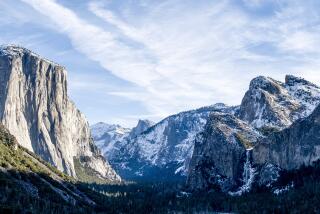National Parks Looking for Ways to Raise Needed Cash : Revenue: Tour operators are already paying more; charges for high-risk activities and other fee hikes are proposed.
- Share via
Facing an annual billion-dollar bill to maintain our national park system, the Clinton Administration is looking for ways to maximize income at those parks. So if you’re visiting one this summer, be prepared for new and increased fees, and the prospect of more in the future.
So far, the Park Service’s focus is on tour operators and high-risk adventurers, and doesn’t much affect the casual park visitor who arrives in a private vehicle. But if Interior Department officials prevail in their current proposal before Congress, the department, which oversees the Park Service, will have new autonomy in setting and spending park fees. And in that case, broad increases are likely.
Park Service officials instituted the fee hike for tour operators in March, setting rates of $25 per entry for commercial vehicles holding up to six passengers, $40 for vehicles holding seven to 25 passengers, and $100 for vehicles holding 26 or more, including the many buses that roll through Yosemite Valley and other high-profile parks. Aircraft carrying tour groups over the Grand Canyon, Haleakala and Hawaii Volcanoes parks also face proposed additional fees, which are still being negotiated. The vehicle fee hikes alone could bring in added revenue of $2.9 million.
(Many tour operators opposed the new fees, saying they would be forced to pass on costs to travelers. But Albert Schmid, president of Far West Travel Corp., a bus tour company based in Marina del Rey, said the new fees so far aren’t costing his firm any more than under the Park Service’s previous $3-per-bus-passenger plan at Yosemite. In fact, Schmid said, the new arrangement seems “more efficient” and takes less time at the gate.)
New fees for high-risk activities are another controversial subject. Since last August, Park Service officials have been working on a trial program to recover the costs of search-and-rescue activities at various parks. The testing ground is Alaska’s Denali National Park, where rangers estimate that the Park Service spent $70,000 in 1993 on 16 missions to rescue lost, injured and stranded climbers on Mt. McKinley. This year, with seven deaths on park mountains and 23 rescue missions so far, the figure could be much higher.
In coming weeks, said J.D. Swed, south district ranger for Denali National Park, Park Service officials there will review public input (more than 220 people wrote in) and consider a three-phase proposal that includes the first-ever user fees for climbers of Mt. McKinley and Mt. Foraker.
The proposal, which would go into effect in time for next year’s climbing season, would bolster pre-climb educational efforts, require registration 60 days in advance (climbers now register on the same day they climb) and establish user fees, to be earmarked for administrative costs and pre-positioning of rescue crews. The fees first proposed were $500 per climber, which were then reduced to $200 per climber early this year. Rangers counted 1,108 climbers last year.
Less conspicuous fee hikes have already been imposed this year at Denali: The popular 87-mile bus ride from the park visitor center to Wonder Lake, formerly free, now carries a fee of $4 per person.
But in the broader scheme of things, the biggest fee-related development could be the National Park Service Entrepreneurial Management Reform Act, also known as House Resolution 4533, now before Congress. The legislation, which probably won’t be addressed until Congress reconvenes next year, would give the Secretary of the Interior authority to impose and adjust admission, recreational and special-use fees for parks, lifting currently mandated caps. (Congress now retains control over fee hikes.) The Park Service would also gain more autonomy over spending.
Among the fee hikes Interior officials have already said they would seek: At Yosemite, Sequoia and Kings Canyon national parks and Death Valley National Monument, where adult fees now are $5 per carload or $3 per individual, the price would rise to $5 per individual. At Grand Canyon, Yellowstone and Grand Teton National Parks, where fees now are $10 per car or $4 per individual, every adult would pay $5. Those increases are expected to double admissions revenues, which amounted to $68 million in 1993.
Where will this money go? Recently, Interior Secretary Bruce Babbitt estimated that the park system had “a present backlog of physical needs totaling over $5 billion.” In an earlier speech, Babbitt said that “for the last several generations, we’ve been exploiting the personnel of the National Park Service . . . . My visits to Park Service housing clusters often remind me of Third World slums.”
“I ask myself if the American people would be willing to pay a little more” than they are now, said Babbitt, “for having the satisfaction of knowing they were helping to sustain (a) resource.”
More to Read
Sign up for The Wild
We’ll help you find the best places to hike, bike and run, as well as the perfect silent spots for meditation and yoga.
You may occasionally receive promotional content from the Los Angeles Times.







